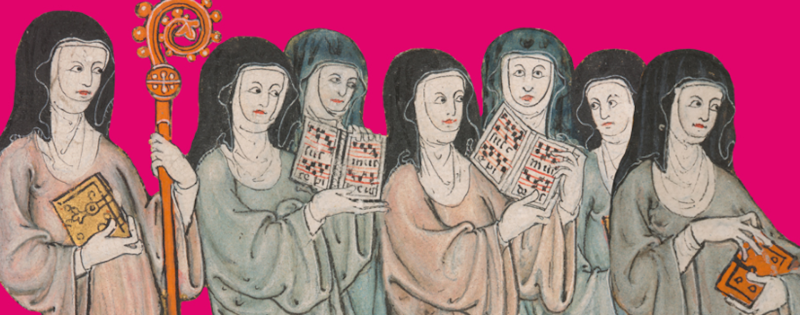Medieval Women: In Their Own Words at the British Library is unmissable
By: Diane Watt (The Conversation)


Something to see for those who might be in London before next March.

The British Library's breathtaking new exhibition, Medieval Women: In Their Own Words, brings to life the experiences, stories and voices of women from the distant past.
The show covers the period from 1100 to 1500, and a range of mainly western countries and cultures. Many of the women featured are from the elite ranks of society: queens, princesses, noblewomen and nuns.
On first entering the gallery, visitors encounter a striking late 13th-century carved stone figure of Eleanor of Castile, who was queen of England from 1274 until her death in 1290. It's one of a series of 12 memorials commissioned by her bereft husband, Edward I, to mark the sites where her body was temporarily set down on its funeral procession from Lincolnshire to Westminster.

Christine de Pizan’s The Book of the City of Ladies. Add Harley MS 4431/British Library
Also on display near the entrance are examples of the work of Hildegard of Bingen and Christine de Pizan. Hildegard was a German abbess, mystic, composer and scholar, and de Pizan was the first professional woman writer in France.
Both were exceptional, highly educated and privileged women, but the exhibition doesn't limit itself only to the most famous medieval women.
These lovely illuminated manuscripts contrast with the next item, a much more mundane - if touching - missive from a woman named Alice Crane. Crane is only known to historians because she corresponded with her friend Margaret Paston during the 15th century. Paston was a Norfolk gentry woman and prolific letter writer. This is one of the few letters we have from the time that testifies to friendship between women. Alice writes: "Thanking you for the great cheer that I had of you when I was last with you with all my heart."
This first part of the exhibition is titled "Private Lives" and explores topics such as cosmetics and perfume and women's medicines and healthcare. Visitors are introduced to women medical practitioners and wet-nurses and find out about education and domestic piety.
There are displays about pregnancy and pregnancy loss, love and marriage, adultery and divorce and property ownership and inheritance. Margery Brews's Valentine letter (believed to be the oldest example of a Valentine's day note) and Gwerful Mechain's poem in praise of the "cunt" are both displayed - and recited.
One of the most striking items on display is a birthing girdle - a parchment covered in prayers and illustrations that was believed to have talismanic properties. Birthing girdles were intended to protect both mother and baby during labour.
The public lives of medieval women
Powerful women visually dominate the second part, "Public Lives". It includes an arresting portrait of Henry VIII's grandmother, Lady Margaret Beaufort, founder of two Cambridge University colleges, and the skull of a lion thought to have been owned by the Margaret of Anjou, leader of the Lancastrians in the Wars of the Roses.
Military conflict is an important theme - there is a book chronicling the history of Shajar al-Durr, Sultana of Egypt, who defeated a crusader army. Nevertheless, several documents provide insight into lives less known.
There's the chancery bill of Maria Moriana, whose name suggests she was a woman of colour. A record of a debt owed to the Jewish businesswoman Licoricia of Winchester who was subsequently murdered in what was very likely a hate crime is displayed. As is a Venetian contract for the sale of an enslaved Russian called Marta. And the record of the interrogation of Eleanor Rykener - a sex worker we would likely recognise today as a trans woman.

Letter of Joan of Arc to the citizens of Riom, November 9 1429. Letter signed by Joan of Arc. Town of Riom, Municipal Archives
Books produced or sold by women scribes, notaries, printers and booksellers lead the visitor into the main display of manuscripts of works by women writers, from Marie de France, a secular poet in the court of Henry II, to Juliana Berners, the probable author of a treatise on hunting, fishing and heraldry.
"Spiritual Lives" introduces nuns, mystics and heretics. There are records relating to Joan of Arc, the peasant French military leader of the hundred years war, who was captured and executed by the English. A letter bearing Joan's signature is exhibited for the first time outside her mother country (in the land of her persecutors, to boot).
Here visitors also encounter the manuscripts of The Revelations of Divine Love by Julian of Norwich and The Book of Margery Kempe. These are two of the earliest works by women to have been written in English and have been brought to life by the artist Tasha Marks in an arresting scent installation. Julian's satanic torments are conjured up by the stink of sulphur. Kempe's scent of angels is evoked by notes of honey, strawberry and caramel.
The curators have done an extraordinary job in making this material accessible to a wide audience. Information panels provide context and correctives. They reveal that the gender pay gap was around 25% at the end of the 15th century, and that only around 1% of women became nuns.
There are interactive displays that can tell you if you would have grounds for medieval divorce, or if you'd have been vulnerable to witchcraft charges (warning: don't keep a box of stolen penises).
The exhibition draws attention to the sheer diversity of the lives and experiences of medieval women in England and beyond, from the quotidian to the sublime. Providing abundant evidence of their learning and scholarship, skills and ingenuity and creativity and artistry, it is, quite simply, unmissable.
Medieval Women: In Their Own Words is at the British Library from October 25 2024 to March 5 2025.





For those who travel, here's another for the bucket list.
I love this kind of stuff